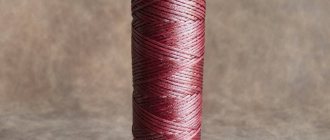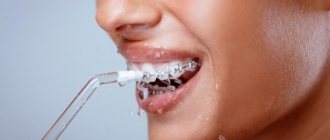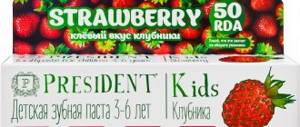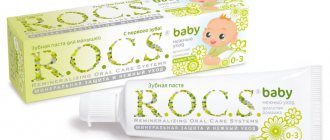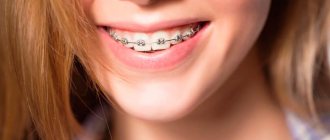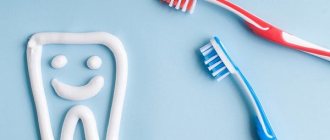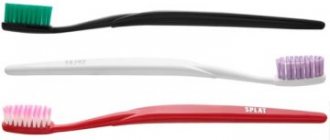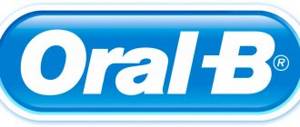Correct teeth cleaning and gums – one of the components of good oral health in general, because it is food debris and bacterial plaque that most often lead to the development of various diseases of the teeth and soft tissues. And one of the effective oral care products is floss for cleaning teeth or, more simply put, dental floss, which allows you to clean the interdental spaces well.
What is floss?
Floss is a special thread designed to clean the interdental spaces. There are several types of floss (they are distinguished by material of manufacture, cross-section, impregnation), which are intended for people with different anatomical structures of teeth.
Dental floss
For narrow gaps between teeth, threads with a small cross-section are used, for wide gaps - round floss or tape.
Types of dental floss
Waxed threads are recommended for those who are using such a device for the first time; unwaxed threads require some skill in use, but clean teeth as effectively as possible.
Waxed dental floss
Flosses with therapeutic and preventive impregnations protect teeth from caries or prevent its occurrence.
Dental floss SPLAT Voluminous waxed Bergamot and lime - photo
What kind of floss is used for brushing teeth?
Today the following types of floss are produced for cleaning teeth and gums :
- With a round cross-section – designed for cleaning wide interdental spaces.
- With a flat section - for cleaning narrow interdental spaces. One of the options for flat threads is interdental tapes.
- Waxed - impregnated with wax, due to which they penetrate into interdental crevices more easily, are more resistant to tearing and have good sliding ability.
- Unwaxed – they clean better due to the fact that upon contact with dental surfaces they become fiber-free and collect plaque more effectively.
- Threads with special impregnation with therapeutic and prophylactic agents or deodorizing substances.
- Threads for individual use.
- Threads for use in the dental office.
How to use floss for braces?
Braces can be cleaned with regular floss, but this will take much longer than usual.
It is best to use waxed dental floss.
For those who wear braces, it is better to use waxed floss, which glides easily between the teeth and does not get stuck between structural elements.
- Cut a piece of thread 30-45 cm long, depending on the structure of the oral cavity.
- Take a piece a few centimeters from one end and carefully pass it under the arch of the braces, being careful not to touch the wire itself. It is more convenient to carry out all manipulations in front of a mirror.
- Wrap the ends of the piece around the index or middle fingers of both hands, insert it into the interdental space so as to “wrap” one of the teeth with thread.
- Gently move the floss up and down so that it rubs against the surface of the teeth.
How to floss with braces
- After completing the procedure, pull out the thread from one side, being careful not to get caught in the braces. If the thread is still stuck between the structural elements, you need to try to free it without making slight movements.
Flossing with braces
Using a floss with a holder
Repeat the procedure with all teeth that are within reach, using a new piece of floss each time.
Video - Dental floss. How to use? How to choose the right one?
Table. Flosses for braces.
| Brand | Peculiarities |
Oral-B (Essential Floss) | Waxed thread made of polymer materials that easily slides between the elements of braces and cleans their surface well. Has a minty flavor. |
Sensodyne Floss Total Care | Expanding fiber floss impregnated with sodium fluoride and wax for dental care and easy glide between teeth and orthodontic components. |
Splat Dental Floss | Waxed thread with various impregnations and silver fibers that have an antibacterial effect on the surface of the teeth. |
| Lacalut | Thin dental floss made of durable nylon with mint impregnation. Easy to use, therefore recommended for beginners. |
Flossing - as an element of daily oral hygiene
Dental floss - floss - is the most important means of individual oral hygiene. Proper flossing removes plaque and food particles from areas that are difficult for a toothbrush to reach. It is recommended to floss daily, as plaque buildup can lead to tooth decay and gum disease.
Dental floss - floss - is the most important means of individual oral hygiene. Proper flossing removes plaque and food particles from areas that are difficult for a toothbrush to reach. It is recommended to use dental floss daily, since the accumulation of plaque always leads to the treatment of dental caries and gum disease.
Doctors from the CrocoDent clinic network note the following advantages from using flosses.
- The risk of developing caries on contact surfaces is reduced.
- Eliminates bad breath, which appears due to accumulated food debris and plaque in the interdental spaces.
- If the thread is impregnated with fluoride, then this is an additional element in the prevention of caries in adults and other dental diseases. Since the tooth enamel is strengthened due to the incoming fluoride elements, and, consequently, the risk of developing caries is reduced. How to choose a suitable dental floss?
Currently produced dental floss can be divided into the following types:
- Waxed threads, which, thanks to wax impregnation, do not separate into individual fibers during use and easily penetrate even between tightly spaced teeth (suitable for beginners in this matter).
- Unwaxed threads (for advanced users).
Rules for using dental floss:
- Tear off a piece of thread 20-40 cm long.
- Wind the thread around your index fingers (using the “spool” principle - one finger more, the other less) and pull, leaving 3 cm of thread in between.
- Carefully insert the floss into the interdental space, leaning on one of the walls of the tooth.
- Gently, without pressure, begin cleaning, moving the thread upward in a “sawing” motion.
- Clean the next area between the teeth by unwinding a new clean part of the thread.
- This way you need to clean the contact surfaces between all teeth.
The floss should not break when you remove it from the interdental space. If the thread constantly breaks, this may be due to the following reasons:
- poor quality dental floss
- caries on the contact surface of teeth;
- low-quality bridge, restoration, filling (rough surface, chip), etc.
It is important to remember that the ideal dental floss is the floss that you are comfortable using, and it cleans the interdental spaces well without injuring your gums!
Return to list of articles
What is superfloss?
Superfloss is a special dental floss designed for those with braces. It consists of three parts: a solid fiber section, a spongy section, and a regular synthetic thread. This device has a number of advantages over simple flossing, as it allows you to most effectively remove food debris and plaque between the teeth and from under the elements of the braces system. The hard end easily penetrates under the braces, the spongy part absorbs plaque not only between the teeth, but also below the gum line.
Super Floss MIRAFLOSS antibacterial dental floss for dentures and braces
Superfloss is used in the same way as regular dental floss - the absorbent part cleans clasps and other parts of the braces well, and regular floss can remove plaque from areas free of orthodontic structures.
Table. Superfloss for braces.
| Brand | Peculiarities |
| Oral-B | Convenient floss for dentures, available in pieces of 50 pcs. Has a pleasant menthol taste. |
| Miradent | A thin (no more than 1.5 mm in diameter) thread is impregnated with chlorhexidine, due to which it not only cleans the interdental spaces, but also destroys harmful bacteria. |
| Mirafloss Implant CHX | A dense, thin thread covered with microscopic bristles that most effectively cleans plaque from braces and teeth. Available in turquoise and pink colors in 1.5 and 2.2 mm reels. |
| GUM IMPLANT | Superfloss with a thickened spongy part, sold in a convenient package of 50 threads. |
Flossing teeth with braces
It is recommended to clean orthodontic structures at least twice a day, morning and evening after meals, using not only floss, but also special toothbrushes and irrigators.
Oral irrigator
With the right choice of dental floss and other dental devices, oral care while wearing braces will be as simple and effective as possible.
What are the benefits of flossing your teeth?
Even the most convenient, modern and “correct” brush is not able to completely clean the tooth surfaces and interdental spaces. Flosses for cleaning teeth allow you to remove plaque and food debris even where a brush simply cannot penetrate, thereby preventing the development of caries and inflammatory gum diseases.
Most often, caries develops just on the lateral surfaces of the teeth, especially in cases where the teeth are located close to each other and it is not possible to clean between them with a brush at all. In addition, if the interdental spaces are poorly cleaned, the gingival papillae are constantly irritated, which can ultimately cause the development of gingivitis. Dental floss , which easily penetrates even narrow interdental spaces and cleanses them of deposits, will help prevent the occurrence of caries and gingivitis
Recommendations for use
It is important to follow some guidelines for proper cleaning:
- Do not use the same piece of floss to clean multiple spaces.
- Clean between each meal, especially after snacks containing sweets or baked goods.
- You need to brush thoroughly, but carefully so as not to irritate or damage your gums.
- If your gum is accidentally touched or injured, you should definitely rinse your mouth with an antiseptic solution - even if the injury is minor.
- If you have periodontal disease, you should always consult your dentist before using floss.
- For children under 7 years old, it is recommended to clean the gaps with thread only with the help of adults, since a small child is not yet able to use floss correctly and may simply swallow it.
